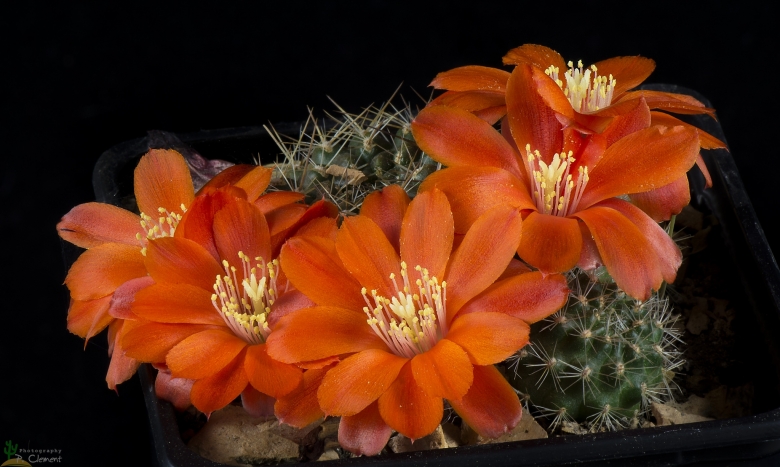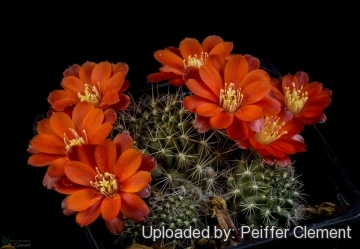= Rebutia lateritia n.n.
Karel Knize catalogue, KK 1519
Accepted Scientific Name: Rebutia fiebrigii (Gürke) Britton & Rose in L.H.Bailey & L.H.Bailey
Stand. Cycl. Hort. 5: 2915. 1916

Aylostera lateritia (Rebutia lateritia) Photo by: Peiffer Clement
KK 1519 (Collector Karel Kníže) Potosi to Ballestro, Bolivia 3800 m.
Origin and Habitat: Potosi to Ballestro, Bolivia at around 3800 metres of altitude (Field number KK1519).
Synonyms:
See all synonyms of Rebutia fiebrigii
back
Accepted name in llifle Database:Rebutia fiebrigii (Gürke) Britton & Rose in L.H.Bailey & L.H.BaileyStand. Cycl. Hort. 5: 2915. 1916Synonymy: 54
back
Description: Rebutia lateritiaSN|34248]]SN|34248]] (Aylostera lateritiaSN|34249]]SN|34249]]) is a nomen nudum (n.n.), a taxonomic proposal of a name that is not valid because it is only a name given in the catalogue of Karel Knize, KK 1519, without sufficient descriptive data. For John Pilbeam these plants are related to Rebutia fiebrigiiSN|4932]]SN|4932]], although in its flowers they remember something to some cacti of the group of Rebutia deminutaSN|4953]]SN|4953]] ssp. kupperiana. More likely it is an intermediate form between the two. Therefore, with some reservations, we can include it in Rebutia fiebrigiiSN|4932]]SN|4932]] in the broad sense because Rebutia lateritiaSN|34248]]SN|34248]] falls into the variability of this species.
Derivation of specific name: Latin lateritia, lateritium “Brick-red” “terracotta” for the brick red colour of its flowers.
Stem: Same as R. fiebrigii.
Spines: Slightly stronger than in standard R. fiebrigii.
Flowers: Orange-red.
Subspecies, varieties, forms and cultivars of plants belonging to the Rebutia fiebrigii group
 Rebutia albipilosa F.Ritter: "White-haired Crown" It is a plant from northern Argentina.The body is made invisible by countless long, soft, hair-like white spines.It produces vibrant orange-red flowers.
Rebutia albipilosa F.Ritter: "White-haired Crown" It is a plant from northern Argentina.The body is made invisible by countless long, soft, hair-like white spines.It produces vibrant orange-red flowers. Rebutia archibuiningiana F.Ritter: The body is made invisible by glassy-white to yellowish, silky, short spines. It produces vibrant orange-red flowers. Distribution: Tarija, Bolivia.
Rebutia archibuiningiana F.Ritter: The body is made invisible by glassy-white to yellowish, silky, short spines. It produces vibrant orange-red flowers. Distribution: Tarija, Bolivia.- Rebutia cintiensis F.Ritter
- Rebutia donaldiana A.B.Lau & G.D.Rowley: "Donald’s Red Crown"n" It develops a dense clump of small, dark heads with brown spines which make a perfect backdrop for the small, dark orange-red, numerous flowers. It quickly begins to form a large, tight mound and it then proceeds to hide it all under a dense blanket of its flowers.
 Rebutia fiebrigii (Gürke) Britton & Rose in L.H.Bailey & L.H.Bailey: "Flame Crown" It’s a Bolivian mountain cactus, found at 3600m altitude, and therefore very hardy. It forms a cylinder about 6cm diameter and 10cm tall with few offsets and it produces striking, flame-red flowers over a long season.
Rebutia fiebrigii (Gürke) Britton & Rose in L.H.Bailey & L.H.Bailey: "Flame Crown" It’s a Bolivian mountain cactus, found at 3600m altitude, and therefore very hardy. It forms a cylinder about 6cm diameter and 10cm tall with few offsets and it produces striking, flame-red flowers over a long season. Rebutia fiebrigii var. azurduyensis (J.de Vries): has yellowish to brownish, silky, short spines and peculiar white blooms. Distribution: Azurduy to La Angostura, Bolivia.
Rebutia fiebrigii var. azurduyensis (J.de Vries): has yellowish to brownish, silky, short spines and peculiar white blooms. Distribution: Azurduy to La Angostura, Bolivia. Rebutia fiebrigii var. densiseta (Cullmann) Oeser: has stronger and very dense brownish spines. Distribution: Chuquisaca, Bolivia.
Rebutia fiebrigii var. densiseta (Cullmann) Oeser: has stronger and very dense brownish spines. Distribution: Chuquisaca, Bolivia.- Rebutia fiebrigii var. vulpes F.Ritter
 Rebutia flavistyla F.Ritter
Rebutia flavistyla F.Ritter Rebutia hoffmannii Diers & Rausch: similar to Rebutia spinosissima, with denser, very fine, tight, white spines, with brownish tips, and outer petals with purple-reddish shades. Distribution: Argentina (Salta) and Bolivia (Tarija).
Rebutia hoffmannii Diers & Rausch: similar to Rebutia spinosissima, with denser, very fine, tight, white spines, with brownish tips, and outer petals with purple-reddish shades. Distribution: Argentina (Salta) and Bolivia (Tarija).- Rebutia ithyacantha (Cárdenas) Diers
- Rebutia jujuyana Rausch
- Rebutia kieslingii Rausch
 Rebutia lateritia n.n.: has brick red flowers. Distribution: Potosi to Ballestro, Bolivia.
Rebutia lateritia n.n.: has brick red flowers. Distribution: Potosi to Ballestro, Bolivia. Rebutia muscula F.Ritter & Thiele: "Little Mouse" It comes from south Bolivia; it is distinguished by its soft white spination and orange flowers and it blooms heavily in May, continuing until September/October with always at least a few flowers. It is especially desirable for the small size of its main body, with the offsets held closely, usually in a pattern reminiscent of a classical sculpture.
Rebutia muscula F.Ritter & Thiele: "Little Mouse" It comes from south Bolivia; it is distinguished by its soft white spination and orange flowers and it blooms heavily in May, continuing until September/October with always at least a few flowers. It is especially desirable for the small size of its main body, with the offsets held closely, usually in a pattern reminiscent of a classical sculpture. Rebutia narvaecensis (Cárdenas) Donald: has 10-30 thin, needle-like whitish to yellowish pines, 2-5 mm long, and numerous pale pink flowers. Distribution: Bolivia. Narvaez (Department of Tarija, O'Connor Province)
Rebutia narvaecensis (Cárdenas) Donald: has 10-30 thin, needle-like whitish to yellowish pines, 2-5 mm long, and numerous pale pink flowers. Distribution: Bolivia. Narvaez (Department of Tarija, O'Connor Province) Rebutia pulchella Rausch
Rebutia pulchella Rausch Rebutia pulchella var. prolifera Rausch
Rebutia pulchella var. prolifera Rausch Rebutia simoniana Rausch
Rebutia simoniana Rausch Rebutia sp. Huari Huari
Rebutia sp. Huari Huari Rebutia vallegrandensis Cárdenas
Rebutia vallegrandensis Cárdenas
 Rebutia lateritia KK 1519 Potosi to Ballestro, Bolivia 3800 m. (Rebutia lateritia) Photo by: Peiffer Clement
Rebutia lateritia KK 1519 Potosi to Ballestro, Bolivia 3800 m. (Rebutia lateritia) Photo by: Peiffer ClementSend a photo of this plant.The gallery now contains thousands of pictures, however it is possible to do even more. We are, of course, seeking photos of species not yet shown in the gallery but not only that, we are also looking for better pictures than those already present.
Read More... Cultivation and Propagation: Rebutia lateritiaSN|34248]]SN|34248]] is a summer grower species that is easy to cultivate.
Growth rate: It is a relatively rapidly growing and easily flowering species that will make clumps given the best conditions.
Soils: It likes very porous standard cactus mix soil. Prefer a neutral or low pH compost, avoid substrata rich in limestone.
Repotting: It is better that they are repotted regularly. Repotting will increase the number and size of stems and will increase the number of flowers produced. Repot yearly until reaching about 100mm in size, then every two or three years will suffice. Repotting is best done at the end of winter but can be done at other times. Do not water for a couple of weeks after repotting to reduce risk of root rot via broken roots. Use pot with good drainage.
Watering: Needs moderate to copious waterings in summer, but do not overwater (Rot prone), keep dry in winter at a minimum temperature of 0°C.
Fertilization: Feed with a high potassium fertilizer in summer.
Hardiness: Reputedly resistant to frost if kept on the dry side prior to, and during, cold weather (hardy to -4 C ° C, or less for short periods).
Exposition: The plant tolerates bright situations but enjoys filtered sunlight or afternoon shade, inside it needs bright light, and some direct sun. Tends to bronze in strong light, which encourages flowering and heavy spine production, but is likely to suffer from sun scorch or stunted growth if over exposed to direct sunlight during the hottest part of the day in summer.
Uses: It is an excellent plant for container growing. It always looks good and stays small. It look fine in a cold greenhouse and frame or outdoor in a rockery.
Pests & diseases: It may be attractive to a variety of insects, but plants in good condition should be nearly pest-free, particularly if they are grown in a mineral potting-mix, with good exposure and ventilation. Nonetheless, there are several pests to watch for:
- Red spiders: Red spiders may be effectively rubbed up by watering the plants from above.
- Mealy bugs: Mealy bugs occasionally develop aerial into the new growth among the wool with disfiguring results, but the worst types develop underground on the roots and are invisible except by their effects.
- Scales: Scales are rarely a problem.
- Rot: This species is particularly easy and accommodating, seldom suffer of cryptogamic diseases. Rot it is only a minor problem with rebutias if the plants are watered and “aired” correctly. If they are not, fungicides won't help all that much.
Propagation: Division, direct sow after last frost. Seeds germinate in 7-14 days at 21-27° C in spring, remove gradually the glass cover as soon the plants will be well rooted (ca 1-2 weeks) and keep ventilated, no full sun for young plants! Seed Collecting: Permit fruit to ripen. Fruit must be significantly overripe before harvesting seed; clean and dry seeds. To make a cutting twist off a branch and permit it to dry out a couple of weeks, lay it on the soil and insert the stem end partially into the soil. Try to keep the cutting somewhat upright so that the roots are able to grow downward.











